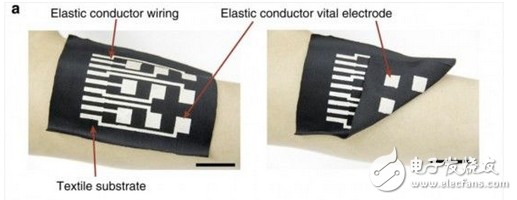Scientists from the University of Tokyo have recently developed a new "electronic ink", a technology that can print electronic components directly onto woven fabrics. This means that in the future, printing conductive elements on shirts will be as easy as printing a logo on our clothes today. Although wearable technology is leading a new technological revolution in the industry, new equipment and devices are being developed every day, but such electronic ink technology can completely change the face of the entire industry and make the production of high-tech clothes mainstream. . A spokesman for the University of Tokyo said at the press conference: "Before this technology, it is possible to print transistors, LEDs, solar cells, etc. on plastic or paper substrates, but these substrates are all rigid or have certain Hardness. Our technology can print electronic components on soft, stretchable fabrics, which will undoubtedly revolutionize wearables because it allows the finished product to fit directly into the human body." Prior to this, the main challenge of this technology was how to maintain high sensitivity and ductility in the simplest possible printing process as an electronic component of "ink". Under the leadership of Professor Takao Someya, this issue has been overcome. Professor Takao Someya's team developed an "ink" made of silver discs, organic solvents, fluorinated rubber and fluorosurfactants. These mixed materials interact to achieve "high conductivity" even in the case of triple stretching. Up to three times the stretchability has far surpassed other products currently on the market; before the development of this electronic ink at the University of Tokyo, the most advanced products of the same type can only achieve 2.5 times extension. Professor Someya said: "Our team's goal is to develop comfortable wearables. This e-ink is just one part of it. Our biggest challenge is to keep the finished product high in the simple one-step printing process. We use a surfactant that allows the silver material to polymerize on the surface of the print layer, thus ensuring high ductility." Based on this new ink, you can develop shirts, trousers or other clothing accessories that can monitor important physiological indicators (heart rate, pulse, muscle activity); the current mainstream products for detecting body data are smart watches and bracelets, such as Fitbit. And Apple Watch. Admittedly, if you have smart clothes, then monitoring your health is as easy as changing clothes in the morning. Now, using the electronic detection components in FibBit and Apple Watch, it is not possible to implant in the fabric; no one would like to wear these rigid fixed rigid bodies every day. But now, "electronic ink" opens a new door to the market for wearable devices. Of course, this new technological breakthrough does not mean that other wearable devices have been sentenced to death. In an interview with Computer World, Professor Someya said: "The emergence of electronic ink does not mean that devices such as smart phones, smart watches, smart glasses will disappear; it just makes the smart device market more diverse." Isn't this kind of diversification exactly what we expect as consumers? RAM/RFM Induction Heating Capacitors RAM/RFM Induction Heating Capacitors Water Pump Capacitor,Water Cooled Condense,Tank Capacitor YANGZHOU POSITIONING TECH CO., LTD , https://www.yzpstcc.com
